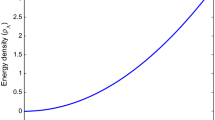Abstract
Field equations of the locally rotationally symmetric (LRS) Bianchi type-I metric with anisotropic fluid are constructed in the framework of Lyra’s manifold. By assuming a hybrid expansion law (HEL) for the average scale factor that yields power-law and exponential-law cosmologies, we model Bianchi type-I space time for the time-dependent displacement field which is proportional to a power-law form of the Hubble parameter. The model provides an elegant description of the transition from cosmic deceleration to acceleration. We discuss the physical behaviors of the derived models with observational constraints applied to late-time acceleration as well as early stages of the Universe. It is observed that HEL Bianchi type I universe is anisotropic at early stage of evolution and becomes isotropic at late times.
Similar content being viewed by others
References
J. A. S. Lima, Phys. Rev. D 54, 2571 (1996).
S. Perlmutter et al., Astrophys. J. 517, 565 (1999).
A. G. Reiss et al., Astrophys. J. 116, 1009 (1998).
D. N. Spergel et al., Astrophys. J. Suppl. 170, 377 (2007).
R. Caldwell and M. Kamionkowski, Ann. Rev. Nucl. Part. S. 59, 397 (2009).
T. Padmanabhan, Phys. Rep. 380, 235 (2003).
E. Tortora and M. Demianski, Astron. Astroph. 431, 27 (2005).
V. F. Cardone et al., Astron. Astroph. 429, 49 (2005).
P. J. E. Peebles and B. Ratra, Astrophys. J. Lett. 325, 17 (1988).
B. Ratra and P. J. E. Peebles, Phys. Rev. D 37, 3406 (1988).
V. Sahni and A. A. Starobinsky, Int. J. Mod. Phys. D 9, 373 (2000).
Y.-Z. Ma, Nucl. Phys. B 804, 262 (2008).
J. A. S. Lima et al., MNRAS 312, 747 (2000).
J. A. S. Lima and J. S. Alcaniz, Astronomy and Astrophysics 348, 1 (1999).
H. Weyl, Mathem. Z. 2, 384 (1918).
G. Lyra, Mathem. Z. 54, 52 (1951).
D. K. Sen, Z. für Physik A: Hadrons and Nuclei 149, 311 (1957).
D. K. Sen and K. A. Dunn, J. Math. Phys. 12, 578 (1971).
W. D. Halford, Austr. J. Phys. 23, 863 (1970).
W. D. Halford, J. Math. Phys. 13, 1699 (1972).
M. S. Berman and F. Gomide, Gen. Rel. Grav. 20, 191 (1988).
K. S. Bhamra, Austr. J. Phys. 27, 541 (1974).
H. Soleng, Gen. Rel. Grav. 19, 1213 (1987).
F. Rahaman, Astroph. Space Sci. 281, 595 (2002).
C. P. Singh, Astroph. Space Sci. 275, 377 (2001).
N. I. Singh, S. R. Devi, S. S. Singh, and A. S. Devi, Astroph. Space Sci. 321, 233 (2009).
O. Akarsu, S. Kumar, R. Myrzakulov, M. Sami, and L. Xu, JCAP 01, 022 (2014).
P. De Bernardis et al., Nature 404, 955 (2000).
R. Stompor et al., Astroph. J. 561, 7 (2001).
T. Koivisto and D. F. Mota, Astroph. J. 679, 1 (2008).
B. Saha, Chin. J. Phys. 43, 1035 (2005).
O. Akarsu and C. B. Kilinic, Gen. Rel. Grav. 42, 763 (2010).
M. Sharif and M. Zubair, Int. J. Mod. Phys. D 19, 1957 (2010).
T. Singh and R. Chaubey, Astroph. Space Sci. 321, 5 (2009).
S. Surendra Singh, Y. Bembem Devi, and M. Saratchandra Singh, Can. J. Phys. 95, 748 (2017).
S. Kumar and C. P. Singh, Astroph. Space Sci. 312, 57 (2007).
C. P. Singh et al.: Astrophys. Space Sci. 315, 181 (2008).
J. P. Singh and P. S. Baghel, Int. J. Theor. Phys. 48, 449 (2009).
M. Visser, Class. Quantum Grav. 21, 2603 (2004).
V. Sahni, T. D. Saini, A. A. Starobinsky, and U. Alam, JETP Lett. 77, 201 (2003).
N. Ahmad and A. Pradhan, Int. J. Theor. Phys. 53, 289 (2014).
Author information
Authors and Affiliations
Corresponding authors
Rights and permissions
About this article
Cite this article
Saratchandra Singh, M., Surendra Singh, S. Anisotropic Dark Energy Models with Hybrid Expansion Law in Lyra’s Manifold. Gravit. Cosmol. 25, 82–89 (2019). https://doi.org/10.1134/S0202289319010110
Received:
Revised:
Accepted:
Published:
Issue Date:
DOI: https://doi.org/10.1134/S0202289319010110



